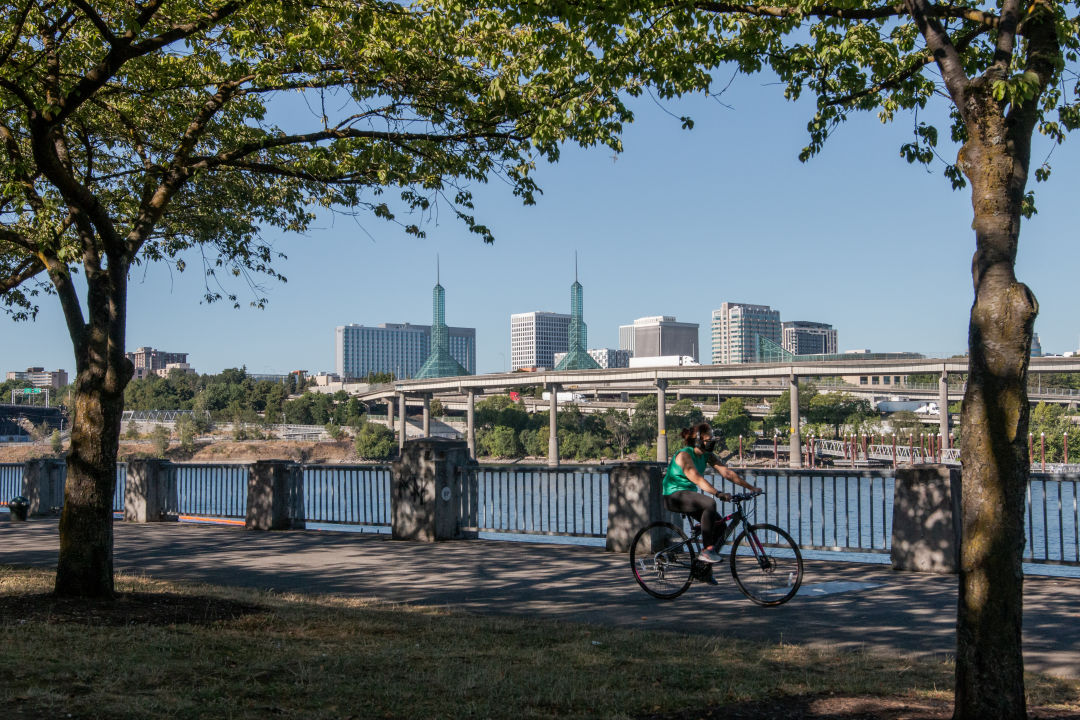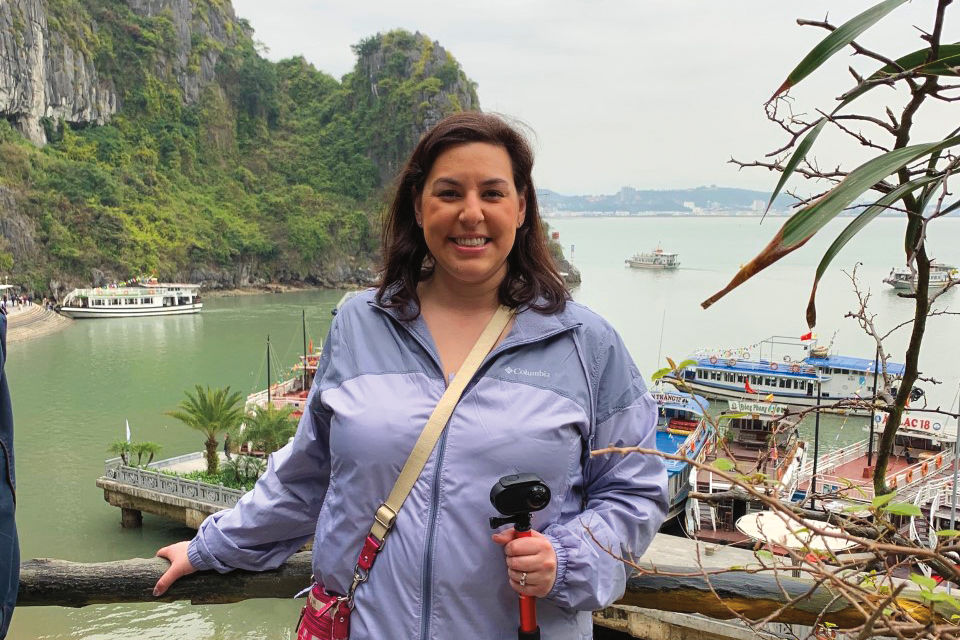Six Months Later: A Quick Look at Coronavirus in Oregon

It's been six months since the first Oregonian tested positive for coronavirus. We look at a few numbers, stats, and events that define the state’s COVID-19 response. (Pictured: A bicyclist rides along the east waterfront in Portland in July.)
Image: Gabriel Granillo
The coronavirus exists in its own Twilight Zone, Kafka-esque reality in which the US is “lower than the world” and time makes absolutely no sense. Has it been six days or six weeks? In fact, it’s been six months.
On February 7, Rebecca Frasure, a 35-year-old woman from Forest Grove, became the first Oregonian known to test positive for the then novel coronavirus. She was aboard a cruise ship called the Diamond Princess near Japan, where she was isolated for four weeks. She recounted her experience later, which you can read here.
As we move forward into an uncertain future, here’s a look at the coronavirus in Oregon at this the six-month point, as well as a few key events that have defined the state’s response.
BY THE NUMBERS
Testing
19,979—total presumptive cases
338—total deaths
18,936—positive tests
406,823—negative tests
425,759—total tested
8,647—total positive tests in the Clackamas, Multnomah, and Washington Counties. According to Multnomah County health officer Dr. Jennifer Vines, “this disease is widespread in Multnomah County.”
Demographics
2,808—the number of people in Oregon age 19 and younger who have been diagnosed with the virus; none has died
4,202—the number of people age 20–29 who have been diagnosed; 2.5 percent were hospitalized; one has died
3,385— the number of people age 30–39 who have been diagnosed; 4.2 percent were hospitalized, three have died
3,220—the number of people age 40–49 who have been diagnosed; 6.3 percent were hospitalized, five have died
2,470—the number of people age 50–59 who have been diagnosed; 10.8 percent were hospitalized, 20 have died
1,593—the number people age 60–69 who have been diagnosed; 20.1 percent were hospitalized, 61 have died
977—the number of people age 70–79 who have been diagnosed; 33.3 percent were hospitalized, 86 have died
681—the number of people age 80 or older who have been diagnosed; 36.6 percent were hospitalized, 152 have died
12—the rate at which Pacific Islanders in Portland are more likely than white Portlanders to contract the coronavirus
* figures from the Oregon Health Authority
Unemployment
1,049—the number of Paycheck Protection Program loans between $1 million and $10 million distributed in Oregon. An additional 8,175 businesses in Oregon received PPP loans of between $150,000 and $1 million, and more than 53,000 recipients in Oregon received loans under $150,000.
658,000—the number of claims the Oregon Employment Department has received for regular unemployment insurance, a 950 percent increase in the number of people the department paid in all of 2019
$3.6 billion—the total amount of benefits the OED has paid to more than 300,000 Oregonians since the pandemic began
11.2—Oregon unemployment rate, as calculated in June
TIME IT WAS AND WHAT A TIME IT WAS
February 7
A 35-year-old Forest Grove woman with mild symptoms is the first Oregonian known to test positive for the novel coronavirus, aboard the Diamond Princess cruise ship docked off Japan. She spends four weeks in isolation in a Tokyo hospital and is discharged March 5.
February 28
The Oregon Health Authority announces the first presumptive case of coronavirus in the state, in a Washington County resident who works within the Lake Oswego school system.
March 8
Oregon declares a state of emergency “due to the public health threat posed by the novel infectious coronavirus.” At this point, there are 14 presumptive or confirmed coronavirus cases in Oregon, 430 cases in the US, and 101,927 cases worldwide. Three days later, on March 11, the World Health Organization (WHO) declares COVID-19 a global pandemic.
March 11
Gov. Kate Brown issues a late-night order for the closure of all K-12 schools, to begin the following Monday and last through April 1. Eventually, in-person classes are canceled for the remainder of the school year. Click here to read about how schools are preparing for the fall semester.
March 14
A 70-year-old man succumbs to COVID-19 at the Portland VA Medical Center. He is reported to be the first person in Oregon known to have died from the disease. That same day, Dr. Maxine Dexter pens a letter to Vice President Mike Pence, who was named head of the Coronavirus Task Force on March 9, regarding the US COVID-19 response.
March 20
The number of confirmed COVID-19 cases reported by the Oregon Health Authority surpasses 100. In a confusing Friday-night press conference, Gov. Kate Brown delivers a “stay home, stay healthy” directive that falls short of an actual order, to the apparent frustration of Portland Mayor Ted Wheeler, and Multnomah County Chair Deborah Kafoury.
March 23
Brown issues Executive Order 20-12. Among other provisions, the order directs Oregonians to stay home “to the maximum extent possible”; prohibits gatherings at which a six-foot distance cannot be maintained between people; and closes salons, gyms, theaters, tattoo parlors, museums, yoga studios, ski resorts, and other types of businesses.
March 26
Wheeler encourages a nightly cheer at 7 p.m. to honor and thank health care workers on the front lines of the COVID-19 pandemic. The call to action is met with clapping hands, banging pots, and even unexpected wine dates, like this one.
April 14
Gov. Kate Brown lays out the framework for reopening the state, but with no specific timeline. The City of Portland announces Wheeler will forgo his salary for the rest of the year and mandates that all nonunion city employees must take 10 unpaid days by October.
April 21
The Oregon Health Authority announces it will be relaxing guidelines for who can get tested for coronavirus, expanding testing to those showing even mild symptoms and those who are part of a group that is at particular risk for contracting the disease. The same day, the state’s coronavirus cases surpass 2,000, as reported by OHA.
April 29
The government of China’s Fujian Providence gifts Oregon with 50,000 medical face masks, which will be delivered to Oregon’s Office of Emergency Management for distribution to counties for frontline workers. Meanwhile, the number of reported deaths due to COVID-19 in Oregon surpasses 100.
May 1
Gov. Kate Brown announces the kickoff of the Key to Oregon study, a partnership with the OHSU-PSU School of Public Health that will enroll 100,000 randomly selected Oregonians for 12 months of temperature and symptom monitoring, with potential follow-up testing. The following week, postcards go out to more than 100,000 Oregon households, inviting them to participate. Also on May 1, hospitals, surgical centers, and dental offices in the state are allowed to resume nonemergency procedures.
May 15
After her initial announcement of Oregon’s three-phase reopening plan, Brown announces the approval for 31 of Oregon’s 36 counties to enter into Phase 1 of her reopening plan.
May 18
Ruling in a church-related case in the morning, a Baker County judge invalidates the governor’s COVID-related executive orders. The Oregon Supreme Court grants a motion that night that puts the judge’s decision on hold and keeps the executive orders in effect.
May 28
The Portland Bureau of Transportation expands its Safe Streets initiative to let businesses convert sidewalks, parking spots, and even roadways into car-free areas for seating, shopping, and other services, coming just one day after Multnomah County officials offered a plan to reopen the county’s economy by June 12. Read more about this initiative here.
June 4
Twenty-six counties in Oregon are approved to enter Phase 2 of the state’s reopening guideline. The governor’s office also relaxes limits on travel within Oregon, though staying local is still recommended, so as not to overwhelm more rural health care systems.
June 11
Brown places a hold on further reopening in Oregon, an order that delays Multnomah County’s application for Phase 1 by at least a week. Her office tweets that the one-week pause, or yellow light, “will give public health experts time to assess what factors are driving the spread of the virus.”
June 19
Multnomah County enters Phase 1 reopening, grouping together with neighboring Washington and Clackamas Counties, which had already entered into Phase 1, for future decisions on the advancement of the reopening process.
June 30
Brown extends Oregon’s state of emergency proclamation for an additional 60 days, citing an uptick in positive coronavirus cases, which at that point had reached more than 8,600. The extended state of emergency is set to last until September 4.
July 1
Oregonians statewide are ordered to wear face coverings in indoor public spaces. The new guidance applies to businesses and members of the public visiting indoor shared spaces, from grocery stores to restaurants to post offices.
July 28
Portland Public Schools announces classes will be online only through at least November 5, with Superintendent Guadalupe Guerrero cautioning that remote learning could extend beyond that, depending on the state of the virus in Oregon. School officials promise virtual learning will be more meaningful and rigorous than it was in the spring, including more regular contacts with teachers.
August 4
Brown’s office tells lawmakers the governor is considering travel restrictions such as those in effect for some other states, with more information expected within a week.




